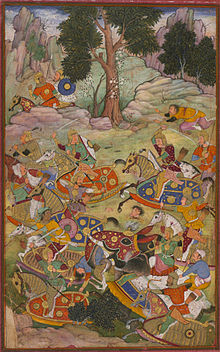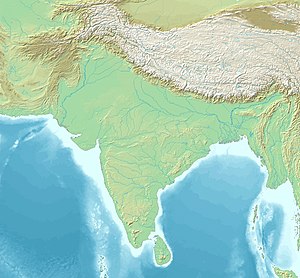
Back معركة باني بت Arabic بیرینجی پانیپت دؤیوشو AZB Бітва пры Паніпаце (1526) Byelorussian পানিপথের প্রথম যুদ্ধ Bengali/Bangla Batalla de Panipat (1526) Catalan Bitva u Pánípatu (1526) Czech Erste Schlacht bei Panipat German Batalla de Panipat (1526) Spanish نبرد نخست پانیپت Persian Panipatin ensimmäinen taistelu Finnish
| First Battle of Panipat | |||||||||
|---|---|---|---|---|---|---|---|---|---|
| Part of Mughal conquests | |||||||||
 The battle of Panipat and the death of Sultan Ibrāhīm | |||||||||
| |||||||||
| Belligerents | |||||||||
|
Mughal Empire Supported By Afghan allies. |
| ||||||||
| Commanders and leaders | |||||||||
|
Babur Supported by: Daulat Khan Lodi | Ibrahim Lodi † | ||||||||
| Strength | |||||||||
|
12,000[1]–25,000 soldiers [2][3] 15–20 field guns[1] |
20,000 regular cavalry[3] 20,000 irregular cavalry[3] 30,000 infantry armed with swords, pikes, bows and bamboo rods[3][2] 1,000 war elephants [4] | ||||||||
| Casualties and losses | |||||||||
| Unknown |
6,000 killed in battle[5] thousands killed while retreating[5] | ||||||||
Location within South Asia | |||||||||
The First Battle of Panipat, on 21 April 1526[6] was fought between the invading forces of Babur and the Lodi dynasty. It took place in North India and marked the beginning of the Mughal Empire and the end of the Delhi Sultanate. This was one of the earliest battles involving gunpowder firearms and field artillery in the Indian subcontinent which were introduced by Mughals in this battle.[7]
Babur defeated the Sultan of Delhi, Ibrahim Lodi, using a combination of tactics such as the use of firearms and cavalry charges. This battle marked the beginning of Mughal rule in India, and its aftermath had a significant impact on the political and social landscape of the country, establishing the Mughal Empire, which lasted for 331 years (1526-1857).[8]
- ^ a b Watts 2011, p. 707.
- ^ a b Chandra 2009, p. 30.
- ^ a b c d Jadunath Sarkar, Military history of India, p. 50.
- ^ "Battles of Panipat | Summary | Britannica".
- ^ a b Jadunath Sarkar, Military history of India, p. 52.
- ^ Zahir-ud-din Muhammad Babur (2023). بابرنامه (Baburnama) [Original Chagatai Turkic]. The Baburnama Project.
- ^ Butalia 1998, p. 16.
- ^ Bates, Crispin (26 March 2013). Mutiny at the Margins: New Perspectives on the Indian Uprising of 1857: Volume I: Anticipations and Experiences in the Locality. SAGE Publications India. pp. 3–4. ISBN 978-81-321-1336-2.
© MMXXIII Rich X Search. We shall prevail. All rights reserved. Rich X Search

